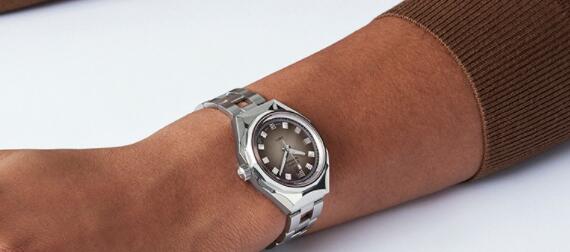
Zenith Defy A3642 Revival
January 18, 2022Zenith has revived the very first model to bear the Zenith Defy name, the A3642 “Bank Vault” from 1969.
The 37mm stainless steel model with a warm grey gradient dial will be produced in exacting detail in a limited run of just 250 pieces, with Zenith going back to the original production plans.
The only cosmetic differences between the original watch and this reissue are the use of sapphire crystal, the exhibition caseback and the use of Super-LumiNova rather than radioactive Tritium which was used originally. Inside beats a 4Hz automatic Elite 670 manufacture movement with a power reserve of 50 hours.
In watch history, 1969 is better remembered for Zenith’s introduction of its high beat automatic chronograph movement, the El Primero, but the octagonal case – which is paired with a 14-sided bezel – predates the use of such geometric shapes on watches like Audemars Piguet’s Royal Oak or Girard-Perregaux’s Laureato.
According to Zenith, the idea behind such a “singularly edgy design” carrying a mechanical movement in 1969 was to demonstrate that mechanical watches still had a future in the face of the competition from then newly developed quartz watches.
The new reissue is water resistant to 300m and features the same steel “ladder” bracelet, so-called because of the absence of alternating mid-links, that was then produced for Zenith by Gay Frères.
While the revival is a limited edition Zenith are also teasing a forthcoming reimagined piece stating they will “soon unveil a modern successor to the original DEFY with a sleeker and more modernistic architecture and a whole new level of performance.”
You know, it feels like it was only yesterday that we were talking about a limited edition Zenith revival watch based on an old model. Oh wait, it was only yesterday! As it’s the beginning of the year, most watch brands are psyching themselves up to release new pieces. Unfortunately, this comes at about the time of year when I should be in hibernation, so if I nod off, then don’t worry, it’s not because of the watch.
Before we go any further, let’s take a look at where the Defy range comes from. While it is probably the range that brings the most cash in for Zenith, the original Zenith Defy A3642 Revival watches were professional tools designed for specific people and came around in 1969. A mixture of shapes, the chunky cases of the first Defy models were octagonal (8-sided) but came with a tetradecagonal (14-sided) bezel. You might associate octagons and bezels that are not round or square with Gérald Genta, and for a good reason, the Royal Oak is an enormously popular watch, but it wasn’t the first. Unlike the Royal Oak, which was meant to bring back Audemars Piguet from the dead and make stainless steel a luxury material, the Defy was built to work just about anywhere. With a 37mm case, water resistance to an incredible 600m of water resistance (this was the late 60s, after all) and a flexible shock absorber for the movement, the Defy was set to be the tool watch of all professionals everywhere. Unfortunately, it didn’t sell too well and never became the big hit it is today. Some say that was because it was released before its time, and that’s probably true, but it does mean these watches are rare to find in untouched condition.
To increase the value of those who own untouched originals while also scuppering anyone else’s chance of getting one at a good price, Zenith Defy A3642 Revival has released re-edition. Unsurprisingly, it’s mostly faithful to the original. It still has a 37mm stainless steel case with two types of ‘gons’ shaping the case and bezel. The dial features a classic brown-ish fumé dial which starts light in the centre and gradually gets darker as you head to the edges and a date window squidged in at 4.30 as it was on the original. The stainless steel ladder-style bracelet is faithful to the original, although I haven’t seen the clasp in any of the press images. The original bracelets were manufactured for Zenith by the bracelet specialists Gay Frères, who also made the bracelets for Audemars Piguet, Patek Philippe, Jaeger-LeCoultre and many more. Today, what’s left of Gay Frères makes bracelets for one company, Rolex, which acquired the bracelet maker in 1998. Around the back is where we see the first of the changes from the original, a sapphire crystal caseback covers the automatic calibre Elite 670, an ultra-thin automatic movement released in the early 90s. It features a 50-hour power reserve and a 4Hz beat rate as the later first-generation Defy models did (earlier models had a 3Hz movement and lack writing on the dial stating this.
